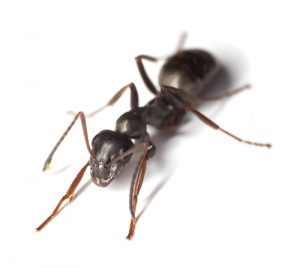Odorous House Ants Like it Cool
By Chris Williams on April 3, 2011.
On any normal April 1st day falling within the workweek, I would be applying preventative insect control treatments to homes throughout my service territory, but today as the snow piles up (6” and counting here where I live), I’ll share an recent incident of odorous house ants showing up in MY home. Here is a bit of background as it relates to the ant sighting. My wife and I have three adopted cats, and the newest one delights in constantly terrorizing one of the other two, especially, at feeding time. Because of this, we’ll often bring the dish to her so she can eat in peace (yes, they’re all very spoiled cats!). One of her favorite spots to hang out is on the window ledge of a bow window. Shortly after she’d abandoned the dish, dozens of odorous house ants began feeding upon the food residue that remained. This occurred in late March (3.27) on a day where the temperature barely made it to the mid-forties. The window where they appeared was at least 40 degrees warmer in the bright sun. I checked outdoors to see if I could observe any trailing activity coming up from the warmed soil, but did not see any so I assume they had taken up residence in the framing of the window itself.
I’ll bet you’ve all heard the story of the plumber’s house with the leaky faucets and the electrician’s house with burned out fixtures, but because I value domestic tranquility, when pests show up at my residence, I take action! Now since my wife is hyper-vigilant about ANY type of chemical exposure to ‘the children’ (the kitties), I chose, well lets’ say I “borrowed” a tamper resistant bait station plus some professional gel bait to treat the problem. Initially, the ants ignored the pet-proofed baits until I removed the cat’s dish. Then, they ‘discovered’ the new food source and fed fairly heavily. It’s been six days now since their last appearance and I’ve even tried to entice them back with their previous favorite food. Game over!!
 So what exactly is an odorous house ant and why is it odorous? The scientific name of this species is Tapinoma sessile. It is very common native species found throughout all of North America. It gives off a peculiar odor when crushed. Some say the aroma smells like coconut, but to me it reminds me more like some type of mold, (moldy coconut maybe!). Worker ants are all 1/16inch long, dark brown to black in color, with a single node (like the carpenter ant) that is obscured by the abdomen. This highly adaptable ant will nest in soil, under stones, forest debris, and occasionally within homes. Odorous house ant colonies can be quite large with up to 10,000 workers and multiple queens. Unlike its formal name, odorous house ant is anything but sessile. Workers are very fast moving, active foragers, and feed on all types of foods. They’ll scavenge meats and also prey upon live insects. They’re very attracted to fruit juices and collect honeydew produced by aphids and other plant feeding insects. Although these ants will sometimes nest in the home, they don’t do any real structural damage, but active trailing odorous house ants in a residential kitchen are a major headache! Good housekeeping combined with exterior chemical control by our expert pest control technicians is the perfect one two punch to knock out odorous ants.
So what exactly is an odorous house ant and why is it odorous? The scientific name of this species is Tapinoma sessile. It is very common native species found throughout all of North America. It gives off a peculiar odor when crushed. Some say the aroma smells like coconut, but to me it reminds me more like some type of mold, (moldy coconut maybe!). Worker ants are all 1/16inch long, dark brown to black in color, with a single node (like the carpenter ant) that is obscured by the abdomen. This highly adaptable ant will nest in soil, under stones, forest debris, and occasionally within homes. Odorous house ant colonies can be quite large with up to 10,000 workers and multiple queens. Unlike its formal name, odorous house ant is anything but sessile. Workers are very fast moving, active foragers, and feed on all types of foods. They’ll scavenge meats and also prey upon live insects. They’re very attracted to fruit juices and collect honeydew produced by aphids and other plant feeding insects. Although these ants will sometimes nest in the home, they don’t do any real structural damage, but active trailing odorous house ants in a residential kitchen are a major headache! Good housekeeping combined with exterior chemical control by our expert pest control technicians is the perfect one two punch to knock out odorous ants.